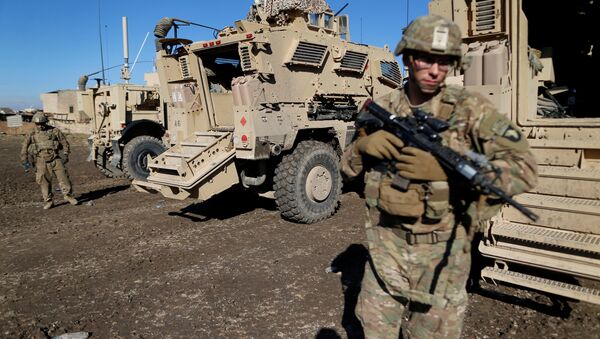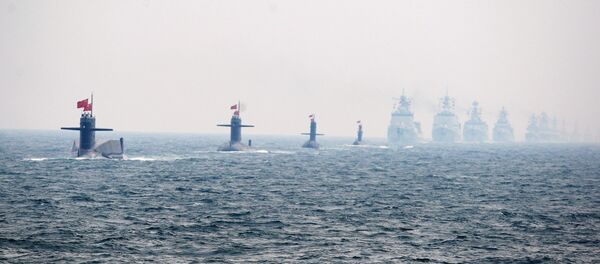Just five nations accounted for 60% of global defence spending in 2018: the United States, China, Saudi Arabia, India and France.
In the US, which has the largest defence budget in the world, military spending grew by 4.6% to reach $649 billion in 2018, growing for the first time since 2010.
Russia has dropped out of the top five defence spenders for the first time since 2006, SIPRI reported, as cited by DefenseNews.
Russia currently ranks sixth in terms of defence spending, at $61.4 billion, but its spending decreased by 3.5% compared with 2017.
Sputnik discussed the reasons behind the hike in US defence spending with Abraham Ait, chief editor of Military Watch Magazine and Oliver Steward, a political strategist in the UK.
While the only country that the US felt threatened by used to be the Soviet Union, "today Russia, China and to some extent North Korea all retain intercontinental range capabilities and the ability to challenge American power — albeit primarily defensively. In seeking to retain military primacy not only in the Western Hemisphere, but globally against a number of highly competent adversaries, the US needs to deploy forces which are both numerous and state-of-the-art, not only to Europe, but also to the Asia-Pacific and to a lesser extent the Middle East," the editor explained.
But at the same time, multiple near-peer competitors are making it more difficult for the US to maintain its dominance and have been cited as a justification for additional spending.
"The sustainability of this remains highly questionable, and will likely force the US either to develop a more efficient defence sector with greater emphasis on more cost effective or asymmetric weapons systems — or to compromise on plans for total military supremacy, at least in the short-term, as assets continue to be stretched thin," Ait said.
READ MORE: Europe's Justification of Military Spending Boost Far-Fetched — Moscow
Political strategist Oliver Steward shares these views, noting that the US is no longer the sole superpower: "On an international level, we're witnessing an increasingly multipolar world, which I would say is a zero sum game of peer-competitors. One of the peer-competitors is Russia and the other one is China."
According to the SIPRI data, China's military spending rose by 5% to $250 billion in 2018, putting it in second after the US, accounting for 14% of world military spending.
But US experts contend that despite the Pentagon spending twice as much as Beijing and the Kremlin combined, Washington believes that China poses a threat to the current balance of power, especially in the Asia-Pacific region.
"In Trump's geostrategic calculus, there's a belief that China, during the next few decades, will become a very important peer-competitor in the Asia-Pacific region. Also, Trump believes that increasing America's military spending and America's military might would give it greater leverage in international affairs to maintain America's predominance and hegemony in the international system," Oliver Steward said.
While the chief editor of Military Watch Magazine noted that the Chinese People's Liberation Army (PLA) is being rapidly modernised and has jumped several generations in its development. The power shift is poised to continue due to three major factors, according to the expert:
"The first is that unlike the United States, China can sustain an increase in its defence budget of over 5% annually for the foreseeable future, roughly in line with its economic growth. The US, by contrast, will continue to see its budget fluctuate, in line with far lower and less consistent growth rates, and the chances of sustained spending growth at even half the rate of China's military remain extremely slim. The second factor is that the PLA, with a budget just a small fraction of America's own (army), can develop comparable and often superior weapons systems at a small fraction of the cost of their American and Western counterparts."
"The hundreds of ageing F-15, F-16 and F-18 fighters and massive but old Ticonderoga Class heavy cruisers are among the costly assets built in the Cold War which are today nearing retirement. The cumulative spending advantage of the US military will thus continue to erode, which will undermine its formerly vast quantitative advantage over China which can today manufacture arms on a comparable and in many cases larger scale."
Ait stressed that the peer competition among the world's leading military powers has made the growth of global defence spending inevitable, but it's not just true among the big players. Smaller allied and even non-aligned states are investing more money into their military:
"The average growth in defence spending among NATO members actually exceeded growth in US spending in 2018, at 5.4%, with 24 of 28 of the alliance's members increasing their defence budgets that year — many by over 5%."
READ MORE: Germany Considers Massive Military Spending Increase Amid Hardware Crisis
In the end, Abraham Ait explained that as competition among global powers continues to escalate, world military expenditure will also likely continue to increase into the 2020s "as the US-led Western Bloc seeks to meet new challenges to its formerly absolute military primacy which will necessitate more defence spending. The race among major powers to develop and deploy new generations of weapons integrating more advanced technologies to outpace their competitors will further necessitate significant investment," the expert concluded.
The views expressed in this article are those of the speaker and do not necessarily reflect those of Sputnik.






